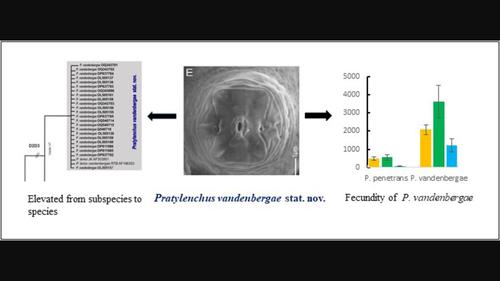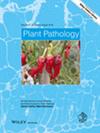Characterization and pathogenicity of Pratylenchus vandenbergae stat. nov. (Tylenchina: Pratylenchidae), a highly pathogenic root-lesion nematode parasitizing crops in Kenya and South Africa
IF 2.4
3区 农林科学
Q1 AGRONOMY
引用次数: 0
Abstract
A highly fecund root-lesion nematode parasitizing a variety of crops was discovered and found to be widespread in Kenya and South Africa. These populations were molecularly identical to Pratylenchus teres teres and P. teres vandenbergae based on D2-D3 of 28S rDNA and Hsp90 sequences. However, based on morphological differences with the original description of P. teres and its different geographical distribution, Pratylenchus vandenbergae stat. nov., previously known as subspecies P. teres vandenbergae, is recognized as a separate species. This species is characterized by a slightly offset labial region with three annuli, en face morphology belonging to Group II, lateral field with four incisures with two outer bands areolated as observed under a light microscope and the inner band also partially areolated at the vulva region as observed in scanning electron microscopy view, a robust stylet (14–17 μm) with rounded knobs and subcylindrical tail with annulated tail tip. This important and common species remained largely under the radar, probably due to identifications based only on sequence similarity, including mislabelled Pratylenchus bolivianus sequences in GenBank. Pathogenicity of P. vandenbergae stat. nov. in finger millet roots was confirmed through acid fuchsin staining, and reproduction and pathogenicity tests in maize, soybean, sunflower and tomato plants demonstrated its capacity to affect crop growth. Life cycle comparison with P. penetrans in vitro showed a similar life cycle length but significantly higher fecundity. Finally, significant differences in pathogenicity and reproduction of P. vandenbergae stat. nov. were found both at genotype level (finger millet genotypes OKHALE-1 & KNE1034) and crop level (maize, soybean, sunflower and tomato plants).

一种寄生于肯尼亚和南非作物的高致病性根病线虫——范登堡Pratylenchus vandenbergae stat11 . (Tylenchina: Pratylenchidae)的特性和致病性
在肯尼亚和南非发现了一种寄生于多种作物的多产的根病线虫,并发现它广泛存在。根据28S rDNA的D2-D3和Hsp90序列,这些种群与圆齿扇鸡和范登堡圆齿扇鸡分子相同。然而,基于与原始描述的形态差异及其地理分布的不同,Pratylenchus vandenbergae stat11 .被认为是一个独立的种,以前被称为亚种P. teres vandenbergae。该物种的特征是唇区略微偏移,有3个环空,面部形态属于II组,侧面有4个切口,光镜下观察到外带2个环空,扫描电镜下观察到内带在外阴区域也有部分环空,花柱(14-17 μm)粗大,圆柄,尾近圆柱形,尾尖环状。这一重要而常见的物种在很大程度上仍未被发现,可能是由于仅仅基于序列相似性进行鉴定,包括在GenBank中错误标记的玻利维亚Pratylenchus序列。通过酸性品红染色证实了范登堡氏病菌对小谷子根系的致病性,并在玉米、大豆、向日葵和番茄植株上进行了繁殖和致病性试验,证实了其对作物生长的影响。体外生命周期比较表明,与外透菌的生命周期长度相似,但繁殖力明显高于外透菌。最后,在基因型水平(指谷子基因型OKHALE-1 &KNE1034)和作物水平(玉米、大豆、向日葵和番茄植株)。
本文章由计算机程序翻译,如有差异,请以英文原文为准。
求助全文
约1分钟内获得全文
求助全文
来源期刊

Plant Pathology
生物-农艺学
CiteScore
5.60
自引率
7.40%
发文量
147
审稿时长
3 months
期刊介绍:
This international journal, owned and edited by the British Society for Plant Pathology, covers all aspects of plant pathology and reaches subscribers in 80 countries. Top quality original research papers and critical reviews from around the world cover: diseases of temperate and tropical plants caused by fungi, bacteria, viruses, phytoplasmas and nematodes; physiological, biochemical, molecular, ecological, genetic and economic aspects of plant pathology; disease epidemiology and modelling; disease appraisal and crop loss assessment; and plant disease control and disease-related crop management.
 求助内容:
求助内容: 应助结果提醒方式:
应助结果提醒方式:


